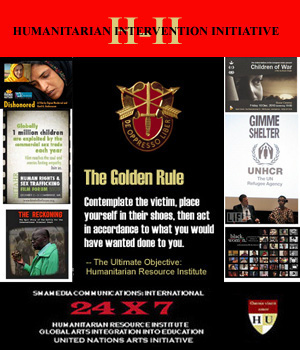30 November 2011
From:
Stephen M. Apatow
Founder,
Director of Research & Development
Humanitarian
Resource Institute
Humanitarian University
Consortium Graduate Studies
Center
for Medicine, Veterinary Medicine & Law
Phone:
203-668-0282
Email:
s.m.apatow@humanitarian.net
Internet:
www.humanitarian.net

CDC. Vital Signs: HIV
Prevention Through Care and Treatment — United States. Released November
29, 2011.
Morbidity
and Mortality Weekly Report (MMWR): November 29,
2011 / 60(Early Release);1-6
Full
Report: Url: http://www.cdc.gov/mmwr/preview/mmwrhtml/mm60e1129a1.htm?s_cid=mm60e1129a1_w
Source:
Medscape: November 29, 2011
According
to this report:
- Only 28% of people infected with HIV in the
United States have
achieved viral suppression, according to a new "Vital Signs" report
from the Centers for Disease Control and Prevention (CDC).
- 1 in 5 people with HIV do not realize they are
infected and, of those who are aware, only 51% receive ongoing medical
care and treatment.
Importance
of an International Public Health Emergency Declaration
In
the context of pharmaceuticals to combat both communicable and
non-communicable diseases, [3] the International Public Health
Emergency Declaration [2] needs to be at the forefront of all
discussions, especially during an International Economic Emergency: [1]
The TRIPS
Agreement,
as clarified by the Doha
Declaration,
makes it clear that WTO members can engage in compulsory licensing with
respect to pharmaceuticals needed to address an international
public health emergency.
Currently, we multiple public health emergencies in continental Africa,
each that would warrant compulsory licenses for all necessary
pharmaceuticals.
World
Aids Day
World
AIDS Day is held on 1 December each year and is an opportunity for
people worldwide to unite in the fight against HIV, show their support
for people living with HIV and to commemorate people who have died.
World AIDS Day was the first ever global health day and the first one
was held in 1988. For additional information, visit:
www.worldaidsday.org
United
Nations Arts Initiative
"Arts
Integration Into Education," through the "United Nations Arts
Initiative" provides a
unique opportunity for members of the arts community to impact
prioritized humanitarian emergencies and relief operations across
the globe. Efforts to "Bridge Unmet Needs to Untapped
Resources,"
includes participation with strategic planning, critical
analysis,
expert think tank development for background discussions, peer reviewed
data compilation and communications that engage decision makers and
target audiences on the grassroots level in 192 United Nations
member countries. For additional information, visit:
www.unarts.org
References
1. Global Fund to
Fight
AIDS -
International Public Health/Economic
Emergency: Humanitarian Resource Institute, 28 November 2011.
http://www.pathobiologics.org/btac/ref/aiie_worldaidsday11282011.html
2.
Africa - International Public Health Emergency: Pathobiologics
International, November 2006. Url:
http://www.pathobiologics.org/btac/UNIHR1292007.html
3. Vet2011 - Global
One Health Catalog 2011 -
NonCommunicable Diseases (NCDs): Pathobiologics International, 17
September 2011. Url:
http://www.pathobiologics.org/btac/ref/aiie_vet9172011.html Ref:
Never
Give Up: Cancer Advocacy Site - HRI/UNArts/SMSI: Pathobiologics
International. Url: www.unevergiveup.org
###
|